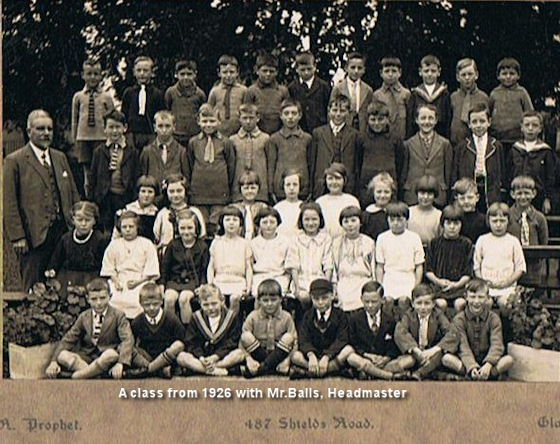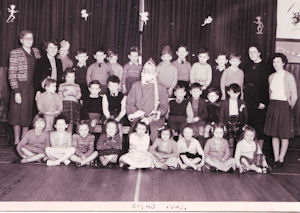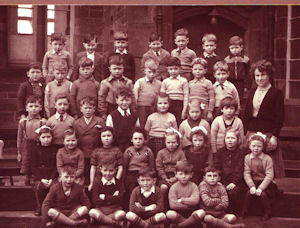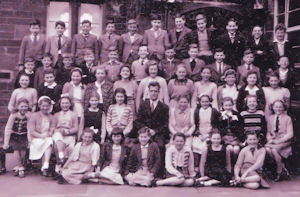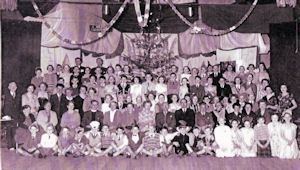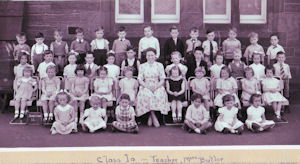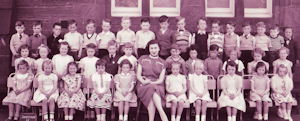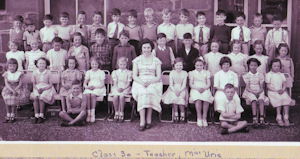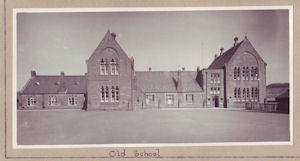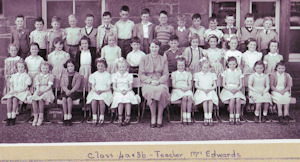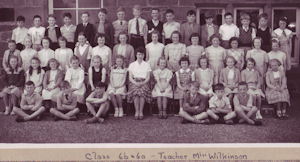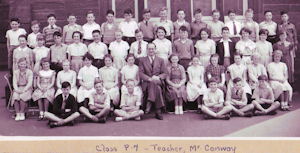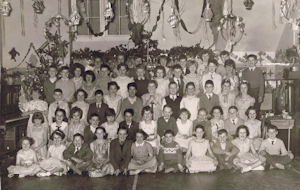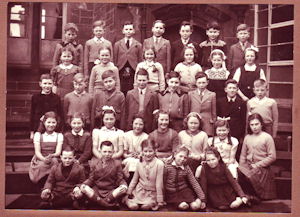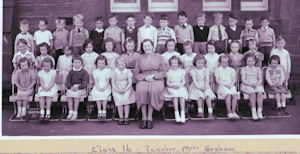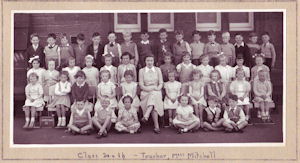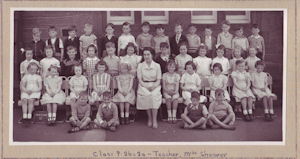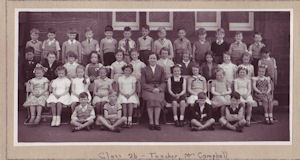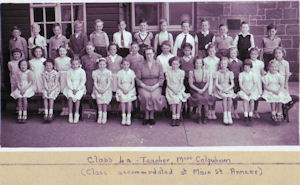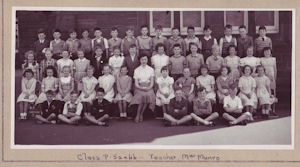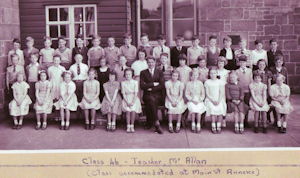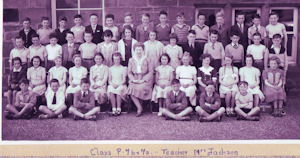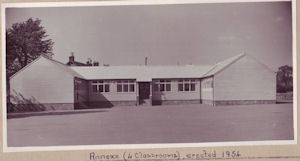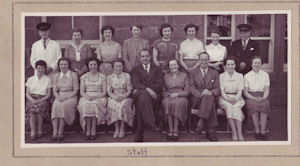A Brief History of Jamestown School from 1865 – 1935
Introduction to the History as it appears on the Vale of Leven website
This is an Introduction to the transcript of a document titled “The Story of Jamestown School through 70 years”. The original handwritten document was prepared by Mr A. G. Donald, who became Headmaster of Jamestown School in 1928, and who delivered its contents as a lecture to commemorate 70 years of Jamestown School in March 1935.
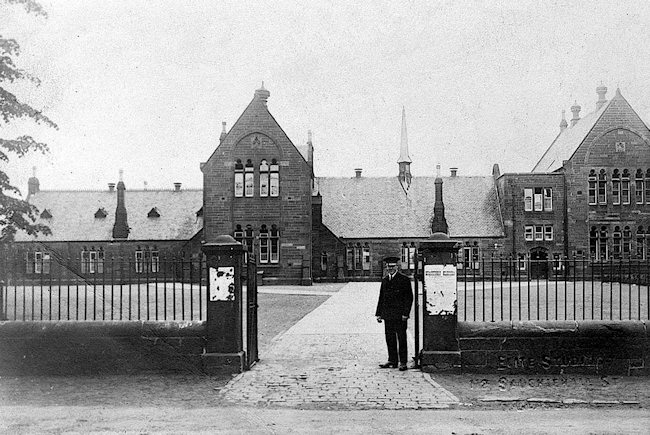
The handwritten notes of this lecture passed into the hands of Miss E. D. Graham, who taught at Jamestown School for many years until the late 1950’s and who lived for many, if not all of those years, in Levenbank Terrace. In 1960, Miss Graham donated the manuscript of the lecture to Dumbartonshire County Libraries.
Partly motivated by the 145th anniversary event which the School is having on December 16th 2008, but equally by the wish to make this enjoyable snapshot of Vale life available to all, it has been transcribed onto the Vale of Leven website in November 2008.
Some references in the history may be obscure or confusing to current readers, therefore a few introductory observations and Notes (at the end) have been added.
The “parochial” school referred to is Bonhill Parish School. A statute of the Scottish Parliament of 1646 required the Heritors (i.e. the local gentry and / or rich people) in each parish in Scotland to provide a schoolhouse in the Parish. A schoolhouse meant a building with adequate living accommodation for the teacher and a classroom in which to teach.
Bonhill Parish covered most of the Vale – excluding Renton which was in Cardross Parish – so it was up to the local gentry to build a school house somewhere in the Vale. In most parishes the parish schoolhouse would be built close to the parish church. That certainly did not happen in Bonhill Parish, for good reasons at the time. Firstly, there were only about 300 people then living in the Parish, and while they were reasonably spread, most lived at the northern end, miles from the church. Equally important, where children were involved, was the question of crossing the Leven in the era almost 200 years before the first bridge was built in the Vale. These considerations made it easy to postpone a decision on where and when to build a schoolhouse.
Perhaps they overdid the postponement a wee bit, because 126 years were to pass before a decision was made to build. However, during these years education was not totally ignored in the parish. Teachers were appointed and paid, and they tended to be itinerant, going to the children rather than the children going to a school – including going over the Stoneymollan to Darleith, which although now part of Cardross, is in Bonhill Parish. Also, to-wards the end of the 126 years, a parish teacher seems to have used his own house as a school, in what is now Drymen Road, Balloch quite close to what are now the gates to Balloch Park.
When in 1772 matters were brought to a head, things were done with a typical Vale flourish, and not one, but two schoolhouses were built. Both were at the north end of the Parish, but there was one on each side of the Leven, and so the difficult question of a river crossing for the children was solved. Smollett, who had recently moved to the Cameron Estate from Place of Bonhill, paid for the western schoolhouse. He agreed to build it on his estate, close to where the house now is on the old Cameron Brae.
The other was built at what was then called Damheid or Damhead of Balloch, but which would shortly become known as Jamestown. It was located just to the north of the present school grounds, on what was then the Dumbarton – Stirling military road and is now Main Street, on or close to the site of the present villa called Bellevue. Both these schoolhouses opened about 1772/3 and both had the same layout - a classroom downstairs and a house for the schoolmaster upstairs. Both were Bonhill Parish School, but each became known by its location, and although the Cameron School moved to the centre of the growing town of Alexandria in 1816, Jamestown School stayed where it was.
It is sometimes said that the old school house was built overlooking the Mill Dam. It was not. When the original schoolhouse was built, the Dam for the Mill of Balloch was at the confluence of the Ballaghan and Carrochan Burns, and the Carrochan Burn directly drove the Mill. That Dam was swept away about 1850. When the replacement dam was built in the middle of the village, then the school did indeed overlook it.
For the first 25 years or so the schoolmasters were supposed to swap school each year, but when a new master, Patrick McNeil, was appointed to Jamestown in 1797, he refused point-blank to swap, and that was the end of that. McNeil, who brooked no interference in the running of the school lasted an astonishing 55 years at Jamestown, until about 1852, when Robert Brown, the first headmaster in this history, took over.
Even after the parish school was established in Jamestown, over the years private individuals opened other schools in the neighbourhood. There was one at Knowehead in Dalvait Road about 1840, and another at Ruchetts or Rickett Moss a bit earlier. These were private enterprises, literally cottage industries, which did not last long – indeed the teacher at Knowehead transferred to the parish school system.
The Free Church School – the building still stands on Carrochan Road at the entrance to the Haldane Estate - was in an altogether different category. It was built as a result of the Disruption in the Church of Scotland in 1843, when many members left to set up a Free Church. It was a well-organised, serious competitor to the Parochial School, housed in a far better building. It survived until the 1873 Education Act totally overhauled education in Scotland, and could probably have survived well beyond that if it had chosen to.
John Neil in his book “Records and Reminiscences of Bonhill Parish” says that Sir Archibald Orr Ewing, as he became, paid for the first new school building on part of the present site about 1856. Dr McGregor in his book referred to in the lecture, thinks it was a little later. In any event, when the school opened on its present site, the old schoolhouse was completely converted to be the headmaster’s house, and stayed that for at least 40 years i.e. around 1900.
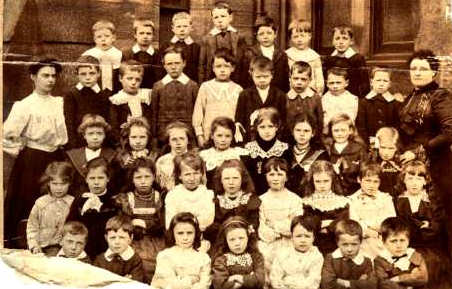
Jamestown School about 1900
By 1863 Mr Robert Brown was well established as headmaster, and it is with the first entry in the School Log Book, which it was his duty to maintain, the 16th December 1863, that the History begins.
All spelling, grammar and layout try to follow the original contents of Mr Donald’s handwritten document.
A few Notes have been added at the end to help explain some of the events / people referred to in the History that may be obscure to-day.
DONATED BY MISS E.D. GRAHAM
JAMESTOWN 5/2/60“The Story of Jamestown School through 70 years”.
Jamestown School
20th and 21st March 1935A.G. Donald
The lecture which I am to deliver to you to-night is based on what is contained within the two log books of Jamestown School – the log-book which I am at present using and which is wearing to an end, and the earlier log-book, which goes back to December 1863.
This earlier log book opens with a rather abrupt and prosaic entry:-
“1863 December 16 Lessons generally well learned, one left for work”. An opening like this leaves one with an unsatisfied feeling. One feels that something must have gone before – something which would have told us how and when the school came into being. One looks to find some written record of the months immediately preceding December 1863, which would have explained the manner and circumstances in which the School had its beginning. But no such record exists; or if it does exist, I have not been able to find it.In my difficulty I have had to think of other sources from which I might glean the needed information. There is, in particular, certain knowledge which is in the possession of the older residents of the place; and had I had time, I would have sought to avail myself of this. However, it was hardly necessary for, as it seems to me, this knowledge has already been dealt with and brought to focus by Dr MacGregor in his excellent little book, recently published; and I don’t think I can do better than quote from it the relevant paragraph:-
“The parochial school about the year 1840 was a two-storey building situated opposite the mill dam, the schoolmaster being one Patrick McNeil. Previous to this, there appears to have been a parochial school in Drymen Road, Balloch. While the school in Jamestown was in existence, an independent school was opened at Knowehead, probably in opposition. After the Disruption of 1843 a Free School came into being and continued until 1873, when it was merged with Jamestown School. Jamestown School (or at least the oldest part of it) was opened about 1864” [Note 1].
On the question of origins, it may be sufficient to leave the matter there.
I am charged with the task of telling the story of Jamestown School through 70 years, and I have had to consider how I might best order the story. I have thought that at least one division of events lies ready to our hands in that there have been three headmasterships, and that we might take the events of each headmaster in turn.
At the outset, however, it may be useful to refer to the list of teachers which you hold in your hands. The teachers number 128. What a spate of oratory must have flowed from the mouths of 128 teachers through the 70 years! But it is as nothing, I should think, to the spate of oratory that flowed back to them from the benches! While we are on the question of statistics, it may be of interest to remark that during the 70 years there have been 39 pupil teachers, 6 teachers of cookery, 14 drill-instructors, 4 compulsory officers, and 5 janitors, who presumably were compulsory officers as well. With regard to the pupils, I may say that my Admission Registers do not go further back than 1888; but, from what I have I am able to give you the rough estimate that 4500 children have passed through Jamestown School in the last fifty years.
During the 70 years which we are reviewing to-night, 28 inspectors in all visited the School. The mention of inspectors will probably be a matter of indifference to this audience; but to those of us who are in the profession the vision of so large a company of these people is not only imposing but formidable!
Let us now look back at the principal happenings of Mr Brown’s headmastership, which extended until 1892. Among the scholars of those days were a considerable number of what were known as half timers – children of school age who were allowed to follow an occupation for half a day, while they attended school during the other half. It will readily be seen that the presence of these half-timers within the School constituted a real difficulty for there could be no uniformity of instruction and the discipline could not have been easy. The half-time system continued all through Mr Brown’s time and into Mr Balls’ time as well. The latest mention I have of half-timers I can discover is in 1895.
The school examinations, four in number, must have been the chief events of the scholastic year – the Presbyterial Examination and the Drawing Examination, held in March; the Public Examination, held just before the closing of the school in June; and the Government Inspection in autumn.
Regarding the Presbyterial Examination, I may give one entry from the log-book:
“1872, March 28. Presbyterial Examination. Present: Messrs Gray, Boyd and Henderson”.
And then in the next year the Presbyterial Examination must have lapsed, presumably owing to the passing of the Education Act; for we have this entry:-
“March 28, 1873. Holiday. No Presbyterial Examination this year. Change of management of School”.
They got their holiday anyway!
The Drawing Examination would doubtless be in the hands of an expert; but the examination was carried through in the presence of members of the School Board, who seem to have been inclined on some occasions to take a hand themselves. Thus under dates in 1875 there are these entries in the log book:-
“July 31 – drawing returns received. 25 passed, 5 proficient, 2 excellent”
Then a month later –
“August 28. The School Committee objects to the word “passed” in entry for week ending July 31. They prefer “25 gave satisfactory evidence of having been taught drawing”.
I do not know what form the Public Examination took. Certainly it seems to have been a fitting finish to the year’s work. Visitors came, and were made welcome. At the examination in 1871 there were no fewer than 120 visitors.
The great event of the school year was, of course, the annual Government Inspection, which attested in a definitive and thorough way the quality of the work done during the year. The character of the Inspector’s Reports, as set forth in the log-book, leaves no manner of doubt as to the sterling work done by Mr Brown and his teachers. Thus in 1874 the report runs:
“The condition of the School continues to reflect the utmost credit on Mr Brown’s industry and ability”.
Then in 1881 the Inspector reports:-“A large proportion of the children are half-timers, but there is no other school in my district, or, I presume, in any other district, where this obstructive element is so successfully dealt with”.
And four years previously this striking testimony had been given:-
“ A large proportion of the scholars are half-timers, an element for which, in most instances, considerable allowance has to be made; but this is a school in which it is unnecessary to notice any drawbacks, unless to call attention to the success with which they are surmounted. The whole results show what a rare combination of industry and skills is capable of accomplishing”.
An important event in the scholastic history of Jamestown took place in December 1873, when the Free Church School was closed and the children transferred. Mr Brown on this occasion remarks in his log-book: “ The average attendance of Free Church School appears from roll to have been 45”. There is an entry in the log-book under date 14th September, 1871, which will have a particular interest for some in this audience. It is this:-
“1871 September. 14. Rev Mr Boyd in charge of School”.
I take it that, for some reason or other, Mr Brown was unable to be in School that day and that Mr. Boyd deputised for him. It appears to me as one of those delightful touches which you get occasionally in country places where the minister and the schoolmaster are on good terms.
During the years 1874 to 1883 a rather novel custom seems to have obtained, whereby schoolmasters were enabled to visit the schools of their professional brethren and examine the work. Thus Jamestown school was visited by Mr. McPhee, Durrisdeer Public School; Mr. Stewart, Drymen; Mr. Fraser, North Berwick; Mr. Buchanan, Cardross; Mr. Grierson, Cambusnethan Parish School, Mr. Duncan, Parish Teacher of Inchture; Mr. Lang, Kilmaronock; and Mr. Smith, Invergordon.
I have tried to detail for you the principal points in Mr. Brown’s survey of his time; but I would now like, so to speak, to go back with you over the record, and pick up certain smaller points which are still interesting, and even important. For nearly eight years Mr. Brown made daily entries in his log book – a rather exacting business. The rule to-day, as I understand it, is that head teachers must make at least one entry per week, and I may say that that is sufficient for me. But daily entries? Occasionally, in his difficult task of recording, Mr. Brown had to fall back upon such general observations as “Lessons well prepared” and “nothing particular”. I have often felt like that. There is one surprising discrepancy in the log book for which I have got no explanation – there is no entry from 11th October, 1865, until 1st October, 1867 – almost exactly two years.
The School was small enough in those days. At the Government Inspection in 1864, 119 pupils were present; and nine years later it is noted that the School “is divided into 3 apartments”. The subjects stated to have been taught at this time were: Geography, Religious Knowledge, Spelling, History, Catechism, Grammar, Composition, Arithmetic, Map-Drawing and Euclid; but this cannot have been the full curriculum, for there is mention afterwards of Domestic Economy, Latin, French, Greek and Mathematics.
At a later stage in his diary, Mr. Brown records two notable appointments:-
1. In 1888 Mr. D. R. Balls took up duty as second master in the School. [Mr Balls was appointed to succeed Mr. Brown four years later].
2. In 1890 Mrs Lewis becomes headmistress, and thereby entered on a service which was to last for 30 years.
Here is an entry which may awaken pleasant memories:-
“1888 August 18. Pupils and teachers attend the Exhibition in Glasgow. All expenses paid by W. E. Gilmour, Esq., Chairman of School Board”. [Note 2]
Under date February 23, 1871, there is an entry which rings as true to-day as it did 64 years ago:
“Lessons not so well prepared. A soiree last night”.
And then on February, 24, 1884, there is this. “Workers from Levenbank Works and elsewhere are frequently in the School grounds. Three were amongst the scholars on Monday last. They were smoking and using bad language. Their names were sent both to the policeman and to the School Board”.
One of the teachers, Mr. Alexander Wilson, enjoys a unique distinction; for he is the only teacher in Mr. Brown’s time of whom it is recorded that he received a gift on leaving.
“Christmas Day, 1879. Mr Alexander Wilson left. He has been appointed second master in Tillicoultry Public School. Before his departure Master Joseph Roxburgh, in the name of the pupils attending the School, presented him with a token of their esteem”.
I would like to say a word about the Pupil Teachers in Mr. Brown’s time. Mr. Brown passed 23 of them through his hands. I fear that some of these P.T.s must have been to Mr. Brown rather a “thorn in the flesh”. There are frequent entries in which Mr. Brown records lateness on the part of P.T.s the lateness varying from 5 to 15 minutes. The P.T.s did not always score, however, as for example –
“1864 February 2. P.T.s 5 minutes late – made up at night”.
On the side of the pupil-teachers, it may be pointed out that they had no easy task. I know, for I was one myself. I have a lively remembrance of the whole business. For me, it meant facing my schoolmaster at half past 7 in the morning to have my lessons heard. This went on till 9. I taught all day from 9.30 to 4, and I must have spent at least 2 hours in the evening preparing my lessons. One does not have to give much thought to a program like that to realise that the lot of a pupil-teacher forty years ago was no sinecure. Yet many of the pupil-teachers made good. Mr. Brown frequently writes that “the P.T.s are working well”, and the successes which they gained later are clear evidence not only of their own mental calibre but of the painstaking tuition of their old schoolmaster.
We come now to the period when Mr. Balls was in charge, and here perhaps we are on more familiar ground. Mr. Balls was headmaster from 1892 till 1928 – nearly 36 years. During this period there were a number of changes on the school buildings. Occasionally you read that the Inspector criticised the School Board for their tardiness in carrying them out. Thus in 1904 it is observed that a partition has been erected in the Infant Room “after long and needless delay”.
Immediately after taking office as Headmaster, Mr Balls must have secured a renovation of the School, for in a report by the Inspector in 1893 we read that “the premises have been immensely improved and brightened, and the Infant Room enlarged”. Still, much remained to be done, for in the following year it is complained that “the ventilation is very defective, while the teaching of 140 pupils simultaneously in 1 room by 4 teachers cannot but be considered unsatisfactory”.Not until four years after wards was this matter adequately dealt with. In the year 1898 there is an entry to the effect that “Standard II has been transferred to the Free Church School till addition to School complete”. The new building was opened in 1899. Seventeen years later came the momentous happening of the fire. Under date 15th March, 1916, there is an entry more eloquent than anything I can say.
“Rooms 3 and 4 at the back of the School took fire on Sunday evening the 12th and were completely gutted. All furnishings, apparatus and school material were completely destroyed. The Qualifying Class Register was not in the Teacher’s desk and hence was saved. The other Register – Senior III (a) – was found and was readable…. In consequence of the fire, the School did not open on the 13th but met on the 14th as usual”.
The happy sequel to this event came on 15th December, 1924, when a Central Hall and class-rooms were opened by Reverend W. M. Goldie, Kilmaronock, chairman of the Education Authority.
From 1902 to 1916, a period of 14 years, the heating system of the School gave a good deal of trouble. The difficulty seems to have been chiefly in relation to rooms at the south end of the School. Rooms 8 and 10 being particularly named. More than one effort was made to improve the heating but to little purpose. In 1913 a complaint was made by a parent with regard to the heating of Room 8, and the complaint was forwarded to the School Board. Action was immediately taken; and if I am to judge by the comparative silence of the log-book on the point in subsequent years, then I would say that the heating system must have been considerably improved. You may take as a footnote to all this that just last year the old boiler was found to be past repair, and a new boiler was installed.
In December 1916, a War savings Association was formed in Jamestown School. In 14 months the total of the deposits had reached £1000, and a holiday was given. The last reference I find to the War Savings Association is in March, 1919, when it is stated that “there are 272 members in the Association and the aggregate of the deposits is £2000 8/-.
For many years Mr. Balls entered pupils for the secondary Education Scholarships granted by the County Council. The scholarships were of £5 each; and the pupils of this School attained a large measure of success in the examinations. Thus in 1899 it is recorded that pupils of the School obtained the 2nd, 3rd, 4th, 5th, 6th and 7th places in the County; and H.M. Inspector reported that “the papers written by the pupils of Jamestown Public School are of outstanding merit”.
Here is an entry in the log-book which will be interesting to the boys (and perhaps to the older boys as well):
“8th September, 1906. The competition for the Wyllie Championship Cup for Physical drill, open to teams from Schools within the County, took place to-day in Millburn Park. A team of 20 boys from Jamestown School, trained by Sergeant-Instructor Reilly, took 1st place in the competition and carried off the Cup”.
A notable event is chronicled under date 30th June, 1921:
“Mr. James Smith, second master, retires to-day, having reached the age limit. He retires after 21 years’ faithful and loyal service in this School”.
And just a year afterwards there is an entry which will be interesting to parents:
“30th June, 1922. Post-Qualifying Classes cease in this School, as all pupils that qualify now proceed to Vale of Leven Academy”.
Perhaps I might give you a few particulars with regard to the number of children on roll over the years.
In 1873 there were 350 children on the roll.
In 1900 (27 years later) there were 511.
The peak number was reached in session 1908-9 – 578.From then onwards, there appears to have been a steady decline until, when Mr Balls left in 1928, the number was 332.
Among members of the School Board who visited the School and signed the Register there is one name which appears in the books more frequently than any other. It is Charles Glen, who visited the School periodically from about 1890 to 1918 – 28 years. Such faithful and disinterested service is worthy of any little tribute that I can give.
While much that is in the log-book gives the impression of flux and change, there is one annual event which is recorded with unfailing persistency – the Moss of Balloch Fair in mid-September, for which the scholars had a holiday. It occurs in 1864; and I have traced it through all the years to 1912.
Before I take leave of Mr. Balls’ headmastership, let me give you a few random points of interest.
“February 14, 1895. Attendance low; weather very severe. Actually impossible for delicate or ill-clad children to come to school. Had a visit from Mr. Jolly, H.M.I.S., to-day. Children granted a holiday on account of Loch Lomond being frozen”.
“17th May, 1895. School closed on Wednesday afternoon on account of freeing of Leven bridges”.
I take it that this refers to the “lifting” of the tolls.“21st December, 1895. Music well taught under Mr Winchester. Judicious selection for part-singing”.
“29th August, 1902. The fall of 4 per cent in the attendance is due to absenteeism after pay-out in local public works. This occurs every fortnight with unfailing regularity”.
“2nd December, 1910. A meeting of electors was held in Senior Room on 29th ult. (Parish Council Election). As a consequence, many desks are marked”.
Here is an entry for the children:-
“11th August 1910. school closed on afternoon of 9th owing to visit of Circus to village”.
“15th April, 1911. Leather school bag to each pupil – executors of Mr. James Coats, Ferguslie, Paisley. Each teacher received a gift”.
“31st October, 1913. School closed this afternoon owing to a visit of Princess Louise (Duchess of Argyll) to cut first sod at proposed Garden City in connection with Argyll Motor Works”. [Note 3].
Mr Balls’ tenure of office came to an end on 27th March, 1928. His valedictory entry in the log-book is so interesting, and withal so characteristic, that I think you will want me to read it to you.
“27th March. My last Entry after a service extending from 10th January 1888! Many changes have occurred during the intervening forty years in every department of school life, all tending towards an improvement in Education and the comfort of the pupils ………….On the fabric alone fine alterations or additions have taken place, in the course of which central heating and improved lighting and ventilation have been introduced. The pupils generally have always been of a good type, and the work of Education has, even if strenuous, been a pleasure. To maintain the standard of education in Jamestown and perhaps to improve it, has always been the aim, and now, in demitting office, I hope that I have passed on to my successor pupils who will compare favourably with those of the past. I have just completed an individual examination of the School, and can testify to their intelligence, ability, alertness and discipline as a whole, and to the interest and happy atmosphere in which, by a well-trained and efficient staff, the work is conducted. From personal experience I am of the opinion that education to-day is incomparably superior to that of the ‘80s and ‘90s. The cast-iron regime of these days is now a something of the past, and a sympathetic attitude to the pupils has evolved in its place. The development of the modern humanistic method in Education is obviously to be commended, and, besides being more definitely natural, is better suited to the time in which we live. I part from my charge with regret, and have nothing but the happiest memories of Jamestown – its school and its people. To-day I retire from office owing to age-limit”.
[There follows a brief account of the presentation to Mr. Balls from the staff and pupils; and, at the close, the Latin word “Vale”.]And now I come to the seven years during which I have been in charge, and you will understand that I have a natural shrinking from saying much about it. In any case, I am not the best one to do it. When you are in the thick of events, and a principal actor in those events, you are not in the best position to take a detached view of the situation. Let me touch lightly on a few points.
During the seven years the roll has fallen from 332 to 240; and, concurrently with that, the school has been reduced from a 9-teacher school to a 6-teacher one. The reason for this decline will be readily appreciated.
Six months after I came here, we held a Cake and Candy sale, at which, with your kind co-operation, we realised the sum of £53. A School Fund was thus instituted; and I will only say of this Fund that it is an exceedingly useful thing for a School to have. To-day the School Fund stands in the neighbourhood of £200. In 1930 the Education Authority acquired for us the playing field in Dalvait Road. It is a great boon. The boys will tell you that the two principal events of my headmastership have been the winning of the Christie Shield in 1930 and the winning of the Russell Cup in 1932.
I have only one thing more to say; but I must say it, for it is dear to my heart. Since I came here, I have bent my energies to establish and foster good relations between the parents and the teaching-staff. How far I have succeeded I must leave to you to judge. I will put it to you this way. When the teacher and the parent pull in contrary directions, the child’s education is brought to a standstill, or at least retarded. When the teacher and parent pull in the same direction, the child’s education goes forward, and it is the child who knows the benefit.
1865 – 1955
Headmasters
Robert Brown
David R. Balls
A.G. Donald
Hamish McPherson David R. Balls Marion Banks Maggie Smith Agnes R Grant Jessie Weddell Margaret Main Jessie F Miller John Rose Marion G. McIntyre James Scott (Mrs) Ellen Lewis (Miss) – Moodie (Miss) - Bain D McIntyre L L Massie Kate McGregor Robert Burdon John W.I. Watt Mary Downie (Mr.) - Andrews James Wilson Alexander Wilson Jeanie Smith (Miss) - Mitchell James McKeady Isabella L. Rodgers James Winchester Andrew P. Davidson (Miss) - Alexander Robert H. Butters David Smith Jeanie Kirkwood Elizabeth C Fergusson (Mr.) - Martin James H. Loudon Jessie Milligan (Mr.) G. Lindsay John W. Tait (Miss) - Clachen (Mr.) - Thomson (Miss) - Cuthbertson Daniel McLaren (Miss) - Campbell John Reid (Miss) - Hogg George Whyte Alexander Young Eliza Young Helen McCallum May W. Roxburgh Netta Neill (Miss) A. Hamilton (Mrs) Annie Cuthbertson (Miss) - McFarlane Mary G. Gilfillan Annie M. Nisbet Mary C. Andrew Maggie McCallum Marion Burleigh Grace K. Gilchrist Catherine Drever Annie M. Burns Janet Watson Elizabeth Shearer Agnes McFarlane Mary M. Manson Susan Campbell Winifred McLaren Agnes Hume Joan M. McDougall (Miss) - Oastler Mary W. McCallum Elizabeth Sharp Elizabeth D. Graham Ellen Ferguson Agnes L. Downie (Miss) - McDonald (Mrs) Agnes M. Barber (Miss) - Paterson Agnes Frame Helen Neill Agnes Lang Annie Irvine Elizabeth H. Sharp Margaret Cornock Christine A. Black Elizabeth Ritchie Ellen H. Barker Margaret Lamont Catherine G.C. Stirling Lilian Jamieson Agnes W. Dougall Jessie More Catherine M. Lang Helen D. McFarlane Robert McDonald Grace Brodie (Miss) - Ritchie Helen Drever Wilhelmina McEwan Martha Colquhoun Agnes G. Scott Catherine S. Shearer Nannie Irving Sarah M. Taylor Catherine C. McRitchie Barbara M. Hood Margaret E.G. McKellar Jessie Munro John A. McPherson Robert C. Adams Mary H. McNicoll Elizabeth B. McFarlane Marjorie I. Campbell Isabella Crawford Pupil Teachers
Helen D. Strachan
Mary Hay
Margaret B. Caldwell
Margaret B Douglas
Jean G. Allan
Annie S. Miller
A Mabel Davidson
John Anderson
Hector McKechnie
Alexander Moodie
Adam Primrose
John McFarlane
Peter Campbell
Jane McAuslan
Margaret Stobo
Thomas McCallum
Jessie Campbell
Annie C Young
Eliza Young
Catherine Drever
Archibald Reid
Elizabeth Lang
Dugald Walker
Kate McConnachie
Robert Wilson
Maggie Smith
Jessie Weddell
Jessie F. Miller
Kate McCallum
Elizabeth SharpMr Balls begins as head
Maggie McCallum
Mary D. McGregor
Alexander C. McLean
Agnes McFarlane
Agnes Parlane
Maggie Cornock
Thomas Hendry
Helen Drever
Jessie More
Elizabeth McFarlane
Alexander McLaren
Jean McDougall
Agnes Glen
May McCallum
Mary McFarlane
Mary McLaren
Drill Instructors etc.
Sergeant Meade (Miss) - Taylor Sergeant Instructor Mack (Miss) E. Smith Sergeant Jamieson Sergeant Major Morrison Sergeant Blaikie (or Blackie) (Miss) - Smith (Infants) Sergeant Instructor Reilly (Mr.) A. Emslie (Miss) - Griffin Isabella S. Lawerence Sergeant Major Henry Williams (Miss) - McLeod Cookery Teachers
(Miss) - Agnew
(Miss) - McArthur
May Flora Macdonald
Marion Stirling
(Miss) - Gilchrist
(Miss) - McNaughtJanitors & Comp. Officers
1876 Mr. Gordon Off. To S.B. (Officer to the School Board)
1907 Mr. Young, C.O.
1910 Mr. Campbell, Janitor
1912 Mr. Mathew Wilson, Janitor
1913 Mr. George Halkett, C.O. [Note 4]
1914 Mr. McKean C.O. (temp)
1920 Mr. Dunc. McCallum Janitor & C.O.
1925 Mr. R. Murray, Janitor & C.O.
1930 Mr. W. Graham, Janitor & C.O.Inspectors
D. Middleton McLeod Angus Macdonald Robert Ogilvie Miss Crawford (Cookery) Dr J.C. Stewart - White James Grigor Major Home W. Y. King W.G. Fraser Mr Forbes - Gunn - Harvey - Day J.H. Murray - Thomson Miss Glaister (Cookery) W. Jolly - Miller - Hood H.M. Burdon A R. Andrew A. Cameron Smith T. McVie W. Hyslop - Wilson (Miss) – (Phys. Trg.)
Images of Jamestown School
We are reproducing a series of images of the school during the 1940s and 1950s. The quality is not so good in some of them but have a look and see if you can recognise anyone here. All of the images can be clicked to view the larger version in a new window.
When the Haldane housing scheme was being built many of the children who were moving in to the area went to Jamestown Primary but it was not large enough to accommodate all of them. The Haldane Primary School was built for the Haldane Kids and an annexe was built at Jamestown.
These images will also be of interest to those who attended Bonhill Primary at this time as the kids from the Napierston scheme were moved to Bonhill in what was a time of flux for local primary schools.
1948 Infant's Christmas Party
Miss Butler's Class about 1949
P7 around 1952/53 with Teacher Jack Logan
Christmas Party 1954
Miss Butler 1955
Miss Crum 1955
Miss Urie 1955
School in 1955 before Annexes
Miss Edwards 1955
Miss Wilkinson 1955
Mr Conway 1955
P6 and P7 Xmas Party 1959
Class of About 1946?
Miss Graham 1955
Miss Mitchell 1955
Miss Shearer 1955
Mrs Campbell 1955
Mrs Colquhoun 1955
Miss Munro 1955
Mr Allan 1955
Mrs Jackson 1955
Jamestown School Annexe 1954
Jamestown School Staff 1955
Notes.
Note 1. The book referred to is “Jamestown Parish 1869 – 1934” published in 1934 and printed at the Lennox Herald office, Dumbarton. The author was Rev. Dr Malcolm McGregor, Minister of the Parish from 1925 until his death in 1953.
Note 2. The Exhibition of 1888 was the first of four major International Exhibitions held in Glasgow over the next 50 years, the last being the Empire Exhibition at Bellahouston Park in 1938. The 1888 exhibition was held at Kelvingrove, and presumably the children travelled to it by train.
The WE Gilmour who paid for the trip was, of course, William Ewing Gilmour who had become Chairman of Bonhill School Board while still just 21 years of age. Both Gilmour and his wife, who was a daughter of William Campbell of Tullichewan, were substantial benefactors in the Vale. He or they paid for the building of both the Gilmour Institute (now Alexandria Library) and the Institute for Women (now the Masonic Temple) in the Street, which was named after him in Alexandria.
Note 3. This was something of a coup for the Vale. Princess Louise, Duchess of Argyll, was Queen Victoria’s daughter, some biographers say her favourite child. She was well ahead of her time as a royal princess, in fact she still would be. She was a feminist, politically liberal, a more than competent artist and sculptress, supporter of modern thought and culture, and very good looking. Supported by her mother, she had refused to marry some minor European, usually German, royalty, but instead had chosen a love match to a British commoner. Admittedly the heir to the Duke of Argyll isn’t exactly a commoner by anyone’s standards but a royal, but it was the first time that the child of a sovereign of the United Kingdom had married anyone but a member of another royal family.
In a pattern that is all too familiar to-day, the couple drifted apart, but by the time Princess Louise visited the Vale she and her husband had been reconciled. She was almost a local. The Dukes of Argyll owned estates and a Castle at Rosneath, which is sometimes portrayed as her residence, particularly by Scottish writers. Of course, technically it was her residence, or at least one of the many, but that doesn’t mean she spent much time there. However, she may well have set out from there for her engagement in the Vale.
The four Garden City houses in Argyll Street have always been something of a mystery, and in particular, why aren’t there more of them? The outbreak of war and Argyll Motors demise in 1914 probably provide the answer. The Garden City movement was certainly under way by 1913, and it was just the sort of avant-garde thinking, which would have appealed to both Princess Louise and the Argyll Motor Company. And of course, Duchess of Argyll, Argyll Motors, Argyll Street has a sort of corny symmetry to it which no doubt appealed to keepers of royal appointments and diaries, then as now. Anyway, the pupils of Jamestown School didn’t care, they were delighted to be out of school for the afternoon.
Note 4. This George Halkett was the father of George Halkett junior who went on to become a County Councillor in the 1930’s and 40’s and after whom Halkett Crescent, Rosshead, is named.

